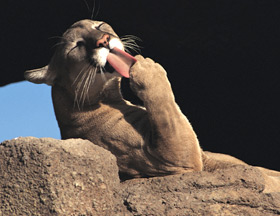 |
|
PHOTO COURTESY ARIZONA/SONORA DESERT MUSEUM
|
One of the museum's mountain lions lounges on a rock.
|
|
|
By Carrie Stern
Arizona Daily Wildcat
Friday, October 10, 2003
Desert Museum educates,entertains visitors
Tucson visitors know it as a tranquil oasis in the desert; residents know it as a scenic symbol of pre-developmental Tucson. The Arizona-Sonora Desert Museum is world-famous for its vast collection of Sonora Desert plants and animals and its natural, picturesque environment. The Desert Museum's reputation as one of southern Arizona's top tourist destinations attracts locals and tourists alike to the 51-year-old zoo, natural history museum and botanical garden.
"We are consistently ranked as one of the top ten zoos in the country," Lorie Anderson, museum marketing manager, said. "We're bringing the unique Sonoran Desert region to life for visitors from all over the world."
The Sonoran Desert bioregion covers an area encompassing southern Arizona, southeast California, and the Mexican states of Sonora and Baja California. The Arizona-Sonora Desert Museum features over 300 animal species and 1,200 plant species native to this region, displayed in a natural exhibit setting. The Desert Museum has replicated several of the Sonoran Desert's diverse plant and animal communities, from Tucson's arid desertscrub surroundings to the mountain woodlands found on Mount Lemmon.
The Desert Museum's two miles of paths lead visitors through 21 acres of natural desert. Docent-led tours are available, and self-guided tour maps are available at the entrance. An orientation room lists events for the day and familiarizes guests with the Sonoran Desert and its characteristics. Trained, uniformed docents are stationed throughout the grounds to interpret displays and answer questions.
After only a few dozen steps along the path, guests may notice that the familiar cactuses are nowhere to be seen. The Desert Grassland exhibit replicates the rolling grasslands of southeast Arizona and houses snakes, owls and the ever-popular prairie dogs. A few steps further, and the vegetation thickens into the lush Mountain Woodland habitat, where sharp-eyed visitors can spot mountain lions, Mexican wolves, black bears and thick-billed parrots. Plants in the area include dangling grapevines, leafy oaks and yellow trumpet bush.
The saguaro-studded Desert Loop Trail is a favorite haunt of javelinas, coyotes and lizards. The natural desertscrub includes chollas, ocotillos and barrel cactuses. Landscaped plant displays include a comparison of different types of palo verde trees and "convergent evolution," a comparative garden of plants that have evolved to look remarkably similar despite living great distances apart.
Cat Canyon is home to several wildcats that call the Sonoran Desert home, including bobcats, ocelots and foxes. The exhibit is constructed so the cats can be viewed from above as well as from below. The overlook also provides broad views of Avra Valley.
In the heart of the Desert Museum grounds, discover what happens when the desert meets a river. The result, the Riparian habitat, is shaded by tall cottonwood trees and is home to playful coatimundis, river otters and beavers. Bighorn sheep, desert tortoises and a variety of native parrots and raptors are located adjacent to the Riparian area.
Relax by an idyllic stream in the completely enclosed Walk-in Aviary, a shady bird paradise that nearly 40 species of native birds call home. The popular hummingbird aviary, newly renovated, contains several species of the tiny, speedy birds.
The Desert Garden and Pollination gardens feature splashes of color from a variety of desert plants. Dozens of showy butterflies and bees float between flowers, joined by the occasional iridescent hummingbird. The landscaped Cactus Garden demonstrates the amazing variety of cactuses and desert plants found in the region, featuring over 100 different species.
The Earth Sciences area contains an awe-inspiring collection of regional minerals and gemstones, a kid-friendly limestone cave and a mine dump where visitors can search for attractive rocks to take home. An overlook at the top of the exhibit offers breathtaking views of the neighboring valleys and mountains, with a sign pointing out what's there in the distance.
The Desert Museum features three climate-controlled, indoor displays. Reptiles and Invertebrates, Fishes and Amphibians and Life Underground allow museum guests to view animals that need cooler temperatures or require enclosed homes.
In addition to the animals on exhibit, docents perform live animal interpretations at scheduled times throughout the day. Keep an eye out for docents toting birds, snakes or invertebrates.
"It's a good place for families," Mary-Lou Palmer, a docent at the museum, said. "It's a nice quiet place where the kids can enjoy watching the animals, and everyone can learn a lot from the interpreters."
A brand new addition to the live animal demonstrations features an animal not normally handled: a rattlesnake! Expert herpetologists carefully handle and show live, venomous rattlesnakes and lizards daily. Never fear - precautions are taken to ensure the safety of visitors, handlers and the snakes themselves. Don't miss this chance to safely view a venomous animal, up close and personal.
The grounds of the Desert Museum contain many strategically placed drinking fountains and restrooms, although bringing a water bottle is suggested. As the majority of the Desert Museum experience takes place outdoors in warm weather, light clothing, comfortable shoes, a hat and sunscreen are recommended to ensure maximum comfort. The Desert Museum features two gift shops and four restaurants where treats from pizza and salads to limeade and ice cream can be procured.
Saturday afternoon's UA-organized Family Weekend visit to the Arizona-Sonora Desert Museum has terminated registration, but the museum is open to visitors every day of the year. Current hours are 8:30 a.m. to 5:00 p.m., and, through the end of October, admission is $9 for adults and $2 for kids aged 6 through 12. The Arizona-Sonora Desert Museum is located at 2021 N. Kinney Rd. Call (520) 883-1380 for directions and more information.
